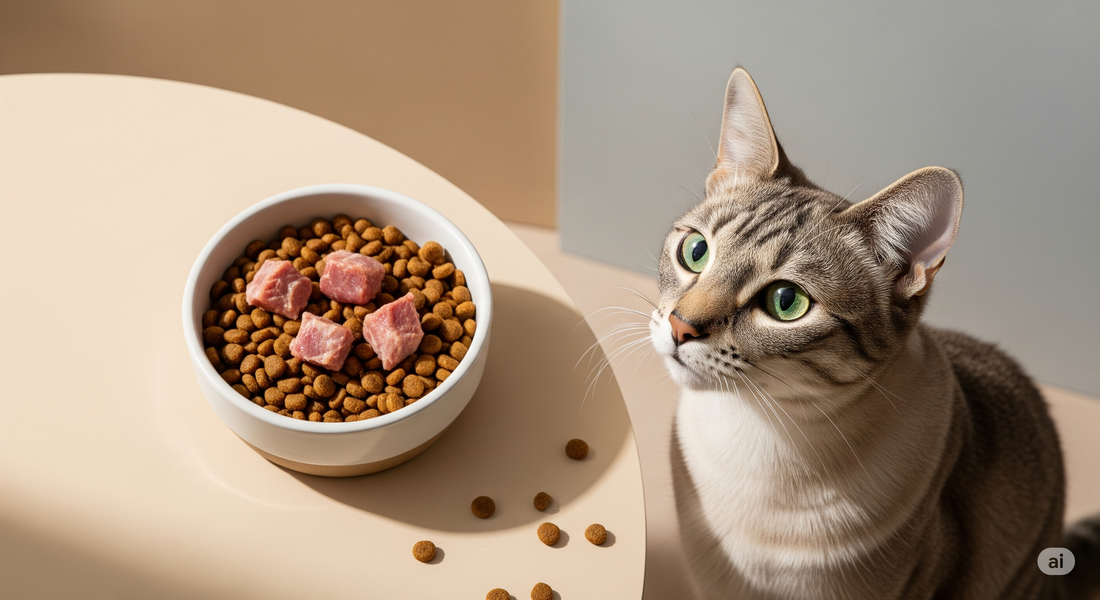
Expert Tips for Choosing the Right Cat Food
Share
Choosing the Right Cat Food: A Complete Guide for Cat Health

Feeding your cat is more than just a daily routine — it’s one of the most important ways you show love and care. The right nutrition supports their energy, keeps their coat shiny, and protects their long-term health. Yet, with so many options on the shelves — from dry kibble to wet food, from grain-free recipes to raw diets, from premium imports to budget-friendly local brands — making the best choice can feel overwhelming. This guide will simplify the process, focusing on what truly matters for your cat’s health and happiness. 
Understanding Your Cat’s Needs
Cats are obligate carnivores. This means they are biologically designed to thrive on animal-based proteins. The healthiest cat foods list a named meat — like chicken, salmon, tuna, or turkey — as the first ingredient. Vague terms such as “meat by-product” or “animal meal” should be treated with caution, especially if the food also contains large amounts of fillers like corn, wheat, or soy. While some grains in small amounts can be harmless, a high-protein, low-filler diet is far closer to what nature intended for your cat.

Quality Standards Matter
When choosing cat food, always check if the brand follows established nutritional standards. Companies that work with veterinary nutritionists and conduct feeding trials ensure that every recipe is complete and balanced for specific life stages. This means your cat is getting the right mix of protein, fats, vitamins, minerals, and amino acids — including taurine, which is essential for heart, brain, and eye health. Transparency is key. Trust brands that clearly list their ingredients and explain where they source them from.

Life Stage Nutrition
A kitten’s needs are very different from a senior cat’s. Kittens grow rapidly and require diets rich in protein, calories, and DHA to support brain and vision development. Adult cats benefit from balanced formulas that maintain weight and muscle tone. Senior cats often do better with fewer calories, joint-supporting nutrients like glucosamine, and easily digestible proteins. Choosing a life-stage-appropriate food ensures your cat’s body gets exactly what it needs at each point in life.

Wet or Dry?
Both wet and dry food have their advantages. Wet food helps with hydration, which is important since cats naturally have a low thirst drive. It’s also often more palatable, making it great for picky eaters. Dry food, on the other hand, is convenient to store and can help keep teeth cleaner through chewing. Many cat owners find that a mix of the two provides the best of both worlds: hydration from wet food and dental benefits from dry food.

The Role of Healthy Ingredients
A truly healthy cat food doesn’t just have protein — it contains the right balance of nutrients. Omega-3 fatty acids from fish oil support skin health and a shiny coat. Probiotics and prebiotics promote good digestion. Adequate calcium supports strong bones, and antioxidants help protect against disease. On the flip side, artificial preservatives, artificial colors, and excessive fillers should be avoided, as they offer no real benefit to your cat’s health.

How to Transition Safely
If you decide to switch your cat’s food, avoid sudden changes. Cats have sensitive digestive systems, and a rapid switch can cause vomiting or diarrhea. Instead, transition over 7–10 days: start with 75% of the old food and 25% of the new food, then slowly increase the new food each day until it’s the only one in their bowl. This gradual approach helps their stomach adjust without stress.

Feeding Well on a Budget
Feeding your cat well doesn’t always mean choosing the most expensive brand. Many mid-range options offer excellent nutrition without breaking the bank. Focus on foods where the first ingredients are real, named meats, and avoid those with long lists of unnecessary fillers. Adding small, safe toppers like plain cooked chicken, sardines, or a drizzle of fish oil can also boost nutrition and flavor without much cost.

The Bigger Picture of Cat Health
Nutrition is the foundation of your cat’s overall health, but it works best when combined with regular vet check-ups, exercise, and mental stimulation. A balanced diet fuels play, supports strong immunity, and can even reduce the risk of chronic conditions later in life. Choosing the right cat food is an investment in both the quality and length of your pet’s life.

Final Thoughts
Feeding your cat is not just about filling a bowl — it’s about giving them the fuel they need to thrive. By focusing on high-quality animal proteins, avoiding unnecessary fillers, selecting food appropriate for their life stage, balancing wet and dry options, and transitioning carefully, you can ensure your cat lives a healthier, happier, and longer life. Your cat depends on you to make the best choice, and the rewards — from brighter eyes to a happier purr — are worth every effort.
